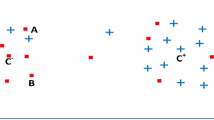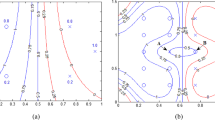Abstract
Support vector machine is a powerful technique for classification and regression problems. In the binary data problems, it classifies the points by assigning them to one of the two disjoint halfspaces. However, this method fails to handle the noises and outliers present in the dataset and the solution of a large-sized quadratic programming problem is required to obtain the decision surface in input or in feature space. We propose the intuitionistic fuzzy proximal support vector machine (IFPSVM) which classifies the patterns according to its proximity with the two parallel planes that are kept as distant as possible from each other. These two parallel ‘proximal’ planes can be obtained by solving a system of linear equations only. There is an intuitionistic fuzzy number associated with each training point which is framed by its degree of membership and non-membership. The membership degree of a pattern considers its distance from the corresponding class center and the degree of non-membership of a pattern is given by the ratio of the number of heterogeneous points to the number of total points in its neighborhood. The proposed technique effectively reduces the impact of noises and distinguishes the edge support vectors and outliers. Computational simulations on an artificial and eleven UCI benchmark datasets using linear, polynomial and Gaussian kernel functions, show the effectiveness of the proposed IFPSVM method. The experiments prove that it can handle large datasets with less computational time and yields better accuracy.










































Similar content being viewed by others
References
Atanassov KT (1999) Intuitionistic fuzzy sets: theory and applications. Physica-Verlag, Heidelberg
Blake CL, Merz CJ (1998) UCI repository for machine learning databases. Department of Information and Computer Sciences, University of California, Irvine. http://www.ics.uci.edu/~mlearn/MLRepository.html
Bradley PS, Mangasarian OL (2000) Massive data discrimination via linear support vector machines. Optim Methods Softw 13(1):1–10
Burges CJ (1998) A tutorial on support vector machines for pattern recognition. Data Min Knowl Disc 2(2):121–167
Cao L, Tay FEH (2001) Financial forecasting using support vector machines. Neural Comput Appl 10(2):184–192
Chen SG, Wu XJ (2018) A new fuzzy twin support vector machine for pattern classification. Int J Mach Learn Cybern 9(9):1553–1564
Cortes C, Vapnik VN (1995) Support vector networks. Mach Learn 20(3):273–297
Cristianini N, Taylor JS (2000) An introduction to support vector machines and other kernel-based learning methods. Cambridge University Press, Cambridge
Fung G, Mangasarian OL (2001) Proximal support vector machine classifiers. In: Proceedings of conference on knowledge discovery and data mining, pp 77–86
Golub GH, Loan CFV (1996) Matrix computations, 3rd edn. The Johns Hopkins University Press, Maryland
Grzegorzewski P (2002) Nearest interval approximation of a fuzzy number. Fuzzy Set Syst 130(3):321–330
Guo B, Gunn SR, Damper RI, Nelson JDB (2008) Customizing kernel functions for SVM-based hyperspectral image classification. IEEE Trans Image Process 17(4):622–629
Guyon I, Matic N, Vapnik VN (1996) Discovering informative patterns and data cleaning. MIT Press, Cambridge, pp 181–203
Ha MH, Huang S, Wang C, Wang XL (2011) Intuitionistic fuzzy support vector machine. J Hebei Univ (Nat Sci Ed) 3:225–229
Ha M, Wang C, Chen J (2013) The support vector machine based on intuitionistic fuzzy number and kernel function. Soft Comput 17(4):635–641
Jayadeva Khemchandani R, Chandra S (2004) Fast and robust learning through fuzzy linear proximal support vector machines. Neurocomputing 61:401–411
Jiang X, Yi Z, Lv JC (2006) Fuzzy SVM with a new fuzzy membership function. Neural Comput Appl 15:268–276
Joachims T (1998) Text categorization with support vector machines: learning with many relevant features. In: European conference on machine learning Springer Berlin Heidelberg, pp 137–142
Khemchandani R, Sharma S (2016) Robust least squares twin support vector machine for human activity recognition. Appl Soft Comput 47:33–46
Lin CF, Wang SD (2002) Fuzzy support vector machines. IEEE Trans Neural Netw 13(2):464–471
Liu X, Li M, Wang L, Dou Y, Yin J, Zhu E (2017) Multiple kernel k-means with incomplete kernels. In: Proceeding of association for the advancement of artificial intelligence conference, pp 2259–2265
Lu J, Zhang E (2007) Gait recognition for human identification based on ICA and fuzzy SVM through multiple views fusion. Pattern Recognit Lett 28(16):2401–2411
Mercer J (1909) Functions of positive and negative type and their connection with the theory of integral equations. Philos Trans R Soc Lond A 209:415–446
Prakash KA, Suresh M, Vengataasalam S (2016) A new approach for ranking of intuitionistic fuzzy numbers using a centroid concept. Math Sci 10(4):177–184
Rezvani S, Wang X, Pourpanah F (2019) Intuitionistic fuzzy twin support vector machines. IEEE Trans Fuzzy Syst. https://doi.org/10.1109/TFUZZ.2019.2893863
Schölkopf B, Tsuda K, Vert JP (2004) Support vector machine applications in computational biology. MIT Press, Cambridge
Song Q, Hu W, Xie W (2002) Robust support vector machine with bullet hole image classification. IEEE Trans Syst Man Cybern 32(4):440–448
Sun Z, Sun Y (2003) Fuzzy support vector machine for regression estimation. IEEE Int Conf Syst Man Cybern 4:3336–3341
Suykens JAK, Vandewalle J (1999) Least squares support vector machine classifiers. Neural Process Lett 9(3):293–300
Tang WM (2011) Fuzzy SVM with a new fuzzy membership function to solve the two-class problems. Neural Process Lett 34(3):209–219
Vapnik VN (1995) The nature of statistical learning theory. Springer, Berlin
Wang Y, Wang S, Lai KK (2005) A new fuzzy support vector machine to evaluate credit risk. IEEE Trans Fuzzy Syst 13:820–831
Wu K, Yap KH (2006) Fuzzy SVM for content-based image retrieval: a pseudo-label support vector machine framework. IEEE Comput Intell Mag 1(2):10–16
Xian GM (2010) An identification method of malignant and benign liver tumors from ultrasonography based on GLCM texture features and fuzzy SVM. Expert Syst Appl 37(10):6737–6741
Yan X, Bai Y, Fang SC, Luo J (2018) A proximal quadratic surface support vector machine for semi-supervised binary classification. Soft Comput 22:6905–6919
Yu R, Qiao L, Chen M, Lee SW, Fei X, Shen D (2019) Weighted graph regularized sparse brain network construction for MCI identification. Pattern Recognit 90:220–231
Yu X (2014) Blurred trace infrared image segmentation based on template approach and immune factor. Infrared Phys Technol 67:116–120
Yu X, Zhou Z, Gao Q, Li D, Riha K (2018) Infrared image segmentation using growing immune field and clone threshold. Infrared Phys Technol 88:184–193
Zadeh LA (1965) Fuzzy sets. Inf Control 8:338–353
Zhou MM, Li L, Lu YL (2009) Fuzzy support vector machine based on density with dual membership. In: Proceedings of the eighth international conference on machine learning and cybernetics. IEEE, Baoding, pp 674–678
Acknowledgements
The authors sincerely thank the reviewers for the recommendation, valuable comments and the interesting suggestions which have considerably improved the presentation of the paper. The first author is grateful to the Ministry of Human Resource Development, India, for financial support, to carry out this work.
Author information
Authors and Affiliations
Corresponding author
Ethics declarations
Conflict of interest
Authors declare that they do not have any conflict of interest.
Ethical Approval
This article does not contain any studies with human participants or animals performed by any of the authors.
Informed Consent
Informed consent was obtained from all individual participants included in the study.
Additional information
Publisher's Note
Springer Nature remains neutral with regard to jurisdictional claims in published maps and institutional affiliations.
Appendix A
Appendix A
Let H be any rectangular matrix of order \(m \times (n+1),~I\) be an identity matrix of order \((n+1)\times (n+1)\) and \(C>0.\) Then the matrix \(\displaystyle \left( H^TH+\frac{I}{C}\right) \) is always invertible.
Proof
Let x be a vector of order \((n+1) \times 1\). Then
This implies that \(H^TH\) is a positive semi definite matrix.
This further yields \(\displaystyle \bigg (H^TH+\frac{I}{C}\bigg ),\) where \(C>0\) is a positive real number, is positive definite matrix and hence it will be invertible. \(\square \)
Rights and permissions
About this article
Cite this article
Laxmi, S., Gupta, S.K. Intuitionistic Fuzzy Proximal Support Vector Machines for Pattern Classification. Neural Process Lett 51, 2701–2735 (2020). https://doi.org/10.1007/s11063-020-10222-x
Published:
Issue Date:
DOI: https://doi.org/10.1007/s11063-020-10222-x




